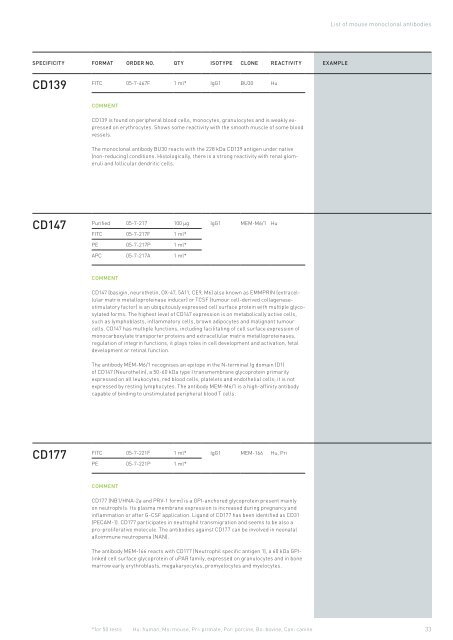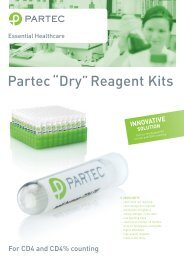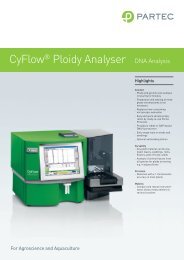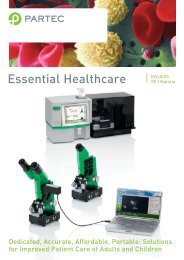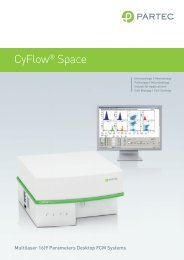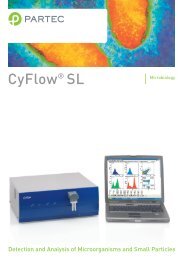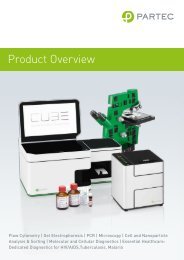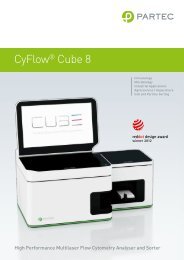Partec Reagents & mAb Catalog
Partec Reagents & mAb Catalog
Partec Reagents & mAb Catalog
You also want an ePaper? Increase the reach of your titles
YUMPU automatically turns print PDFs into web optimized ePapers that Google loves.
sPecificity format order no. Qty isotyPe clone reactivity examPle<br />
cd139 FITC 05-7-467F 1 ml* IgG1 BU30 Hu<br />
comment<br />
CD139 is found on peripheral blood cells, monocytes, granulocytes and is weakly expressed<br />
on erythrocytes. Shows some reactivity with the smooth muscle of some blood<br />
vessels.<br />
The monoclonal antibody BU30 reacts with the 228 kDa CD139 antigen under native<br />
(non-reducing) conditions. Histologically, there is a strong reactivity with renal glomeruli<br />
and follicular dendritic cells.<br />
cd147 Purified 05-7-217 100 µg IgG1 MEM-M6/1 Hu<br />
FITC 05-7-217F 1 ml*<br />
PE 05-7-217P 1 ml*<br />
APC 05-7-217A 1 ml*<br />
comment<br />
CD147 (basigin, neurothelin, OX-47, 5A11, CE9, M6) also known as EMMPRIN (extracellular<br />
matrix metalloproteinase inducer) or TCSF (tumour cell-derived collagenasestimulatory<br />
factor) is an ubiquitously expressed cell surface protein with multiple glycosylated<br />
forms. The highest level of CD147 expression is on metabolically active cells,<br />
such as lymphoblasts, inflammatory cells, brown adipocytes and malignant tumour<br />
cells. CD147 has multiple functions, including facilitating of cell surface expression of<br />
monocarboxylate transporter proteins and extracellular matrix metalloproteinases,<br />
regulation of integrin functions, it plays roles in cell development and activation, fetal<br />
development or retinal function.<br />
The antibody MEM-M6/1 recognises an epitope in the N-terminal Ig domain (D1)<br />
of CD147 (Neurothelin), a 50-60 kDa type I transmembrane glycoprotein primarily<br />
expressed on all leukocytes, red blood cells, platelets and endothelial cells; it is not<br />
expressed by resting lymphocytes. The antibody MEM-M6/1 is a high-affinity antibody<br />
capable of binding to unstimulated peripheral blood T cells.<br />
cd177 FITC 05-7-221F 1 ml* IgG1 MEM-166 Hu, Pri<br />
PE 05-7-221P 1 ml*<br />
comment<br />
CD177 (NB1/HNA-2a and PRV-1 form) is a GPI-anchored glycoprotein present mainly<br />
on neutrophils. Its plasma membrane expression is increased during pregnancy and<br />
inflammation or after G-CSF application. Ligand of CD177 has been identified as CD31<br />
(PECAM-1). CD177 participates in neutrophil transmigration and seems to be also a<br />
pro-proliferative molecule. The antibodies against CD177 can be involved in neonatal<br />
alloimmune neutropenia (NAN).<br />
The antibody MEM-166 reacts with CD177 (Neutrophil specific antigen 1), a 60 kDa GPIlinked<br />
cell surface glycoprotein of uPAR family, expressed on granulocytes and in bone<br />
marrow early erythroblasts, megakaryocytes, promyelocytes and myelocytes.<br />
*for 50 tests<br />
Hu: human, Ms: mouse, Pri: primate, Por: porcine, Bo: bovine, Can: canine<br />
List of mouse monoclonal antibodies<br />
33


